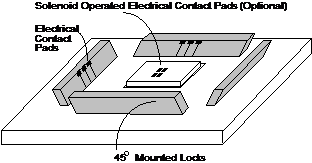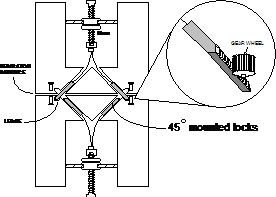





Published on Feb 14, 2025
In order to respond to rapidly changing environment and market, it is imperative to have such capabilities as flexibility, adaptability, reusability, etc. for the manufacturing system. The fractal manufacturing system is one of the new manufacturing paradigms for this purpose.
A basic component of fractal manufacturing system, called a basic fractal unit (BFU), consists of five functional modules such as an observer, an analyzer, an organizer, a resolver, and a reporter. Each module autonomously cooperates and negotiates with others while processing its jobs by using the agent technology. The resulting architecture has a high degree of self-similarity, one of the main characteristics of the fractal. What this actually means in this case is something that when you look at a part of it, it is similar to the whole object.
Some of the fractal specific characteristics are:
Self-similarity
Self-organization
Goal-orientation
Fractal Robot is a science that promises to revolutionize technology in a way that has never been witnessed before. Fractal Robots are objects made from cubic bricks that can be controlled by a computer to change shape and to reconfigure themselves into objects of different shapes. These cubic motorized bricks can be programmed to move and shuffle themselves to change shape to make objects like a house potentially in few seconds. It is exactly like kids playing with Lego bricks and making a toy house or a toy bridge by snapping together Lego bricks, except that here we are using a computer.
This technology has the potential to penetrate every field of human work like construction, medicine, research and others. Fractal robots can enable buildings to build within a day, help perform sensitive medical operations and can assist in laboratory experiments. Also, Fractal Robots have built-in self repair which means they continue to work without human intervention. Also, this technology brings down the manufacturing price down dramatically.
A Fractal Robot resembles itself, i.e. wherever you look at, any part of its body will be similar to the whole object. The robot can be animated around its joints in a uniform manner. Such robots can be straight forward geometric patterns/images that look more like natural structures such as plants. This patented product however has a cubical structure.A fractal cube can be of any size. The smallest expected size is between 1000 and 10,000 atoms wide. These cubes are embedded with computer chips that control their movement.
Considerable effort has been spent in making the robotic cube as simple as possible after the invention had been conceived. The design is such that it has the fewest possible moving parts so that they can be mass produced. Materials requirements have been made as flexible as possible so that they can be built from metals and plastics which are cheaply available in industrial nations but also from ceramics and clays which are environmentally friendlier and more readily available in developing nations.
The cube therefore is hollow and the plates have all the mechanisms. Each of these face plates have electrical contact pads that allow power and data signals to be routed from one robotic cube to another. They also have 45 degree petals that push out of the surface to engage the neighboring face that allows one robotic cube to lock to its neighbors. The contact pads are arranged symmetrically around four edges to allow for rotational symmetry .

The cube therefore is hollow and the plates have all the mechanisms. Each of these face plates have electrical contact pads that allow power and data signals to be routed from one robotic cube to another. They also have 45 degree petals that push out of the surface to engage the neighboring face that allows one robotic cube to lock to its neighbors. The contact pads could be on the plates themselves or be mounted separately on a purpose –built solenoid operated pad as shown in figure 1.2
The contact pads are arranged symmetrically around four edges to allow for rotational symmetry. A 3D rendered image of what the robotic cube like in practice is shown in figure 1.3
The contact pads are shown in figure, what is shown are 4 V-shaped grooves running the length of the plate that allows the petals to operate so that the cubes can lock to each other using its internal mechanisms. In apart from the petals on the surface and the contact pads as illustrated, there are virtually no visible moving parts in the cube. The cubes have inductive coupling to transmit power and data signals. This means there are no connectors on the surface of the robotic cube. This is most important. If connectors are used wiring problems may follow. Also, we have to build connectors that have to scale a nanometer dimensions which is a more difficult option than inductive couplers. Unlike connector pads, inductive coupler scales very well. Hence this is the reason for not using connector pads.
If inductive couplings are the only connectors used, then the cubes can be manufactured with a smooth surface. These cubes can be sealed to protect them from the elements and tiled to make a fractal computer unit. Some type of joining method is employed such as magnetic locks to ensure that a collection of cubes remain rigid when assembled into large computers.
The wedges are pushed in and out of the slots with the aid of a motor. Each wedge could be directly driven by single motor or they could be driven as a pair with the aid of a flexible strip of metal. The wedges having serrated edges engage the neighboring robotic cube sitting on a ledge such that a separation distance is always maintained between the robotic cubes as shown in figure 2.1. The separation distance allows the robotic cubes to-

Figure 2.1 Figure2.2
-slide with minimal friction. The serrated edges are engaged by either a gear wheel or a large screw thread running the length of the slot which moves the wedges along as shown in figure 2.2. Because the wedges are mounted at an angle, the robotic cubes cannot separate when they are engaged. With the use of the screw mechanism to move the wedges, the robotic cubes have very heavy lifting capabilities. Also, with these screws, should the system experience power failure during an operation, the robot stops immediately and safely without any form of slip or instability.
| Are you interested in this topic.Then mail to us immediately to get the full report.
email :- contactv2@gmail.com |